#georgian myth
Photo









georgian mythology: mindort batoni
mindort batoni is the god of valleys, fields, and wild flowers. humans have to ask his permission before exploring or attempting to cultivate the fruitful lands that make up his domain.
270 notes
·
View notes
Text
"You were to take her home."
"The lady is rather... unbiddable."
"Thank you. That might well be the nicest thing anyone has ever said about me."
Sarah McLean, A Rogue by Any Other Name
#book quotes#bookish quotes#book quotations#sarah maclean#a rogue by any other name#regency era#regency romance#georgian era#greek retelling#greek myth retellings#hades and persephone#hades x persephone retelling#hades x persephone#penelope#marquess of bourne#page 366
12 notes
·
View notes
Text
Christmas & Birthday Book Haul
WARNING: I’VE INCLUDED FOUL HEART HUNTSMAN BY CHLOE GONG IN THIS POST. BECAUSE OF THIS THERE ARE SPOILERS FOR THE THESE VIOLENT DELIGHTS DUOLOGY AND FOUL LADY FORTUNE IN THE BLURB I’VE GIVEN,
As always I’ve combined these two lists because my birthday is two days after Christmas. They are in no particular order.
As Long as the Lemon Trees Grow by Zoulfa Katouh
Salama Kassab is a pharmacy…
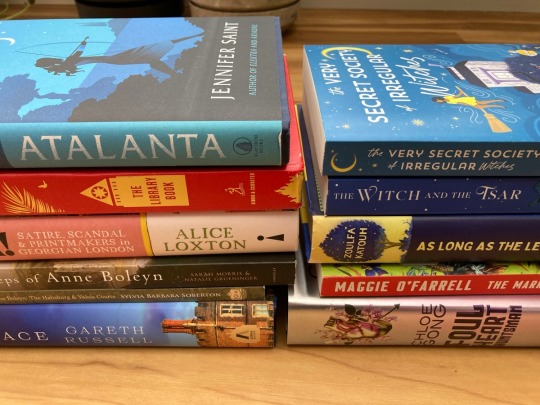
View On WordPress
#18th century#Alice Loxton#Anne Boleyn#As You Like It#Baba Yaga#Baba Yaga story#Books#Books About Libraries#Chloe Gong#England#English History#Fiction#Folklore#Folklore Retelling#Found Family#Gareth Russell#Georgian London#Greek Mythology#Greek Myths#Hampton Court Palace#Historical Fiction#History#Italian History#Italy#Jennifer Saint#Librarians#Libraries#Library Fires#Los Angeles Public Library#Los Angeles Public Library Fire
1 note
·
View note
Text
Gold Turtle Necklace from Ancient Colchis (modern-day Georgia/South Caucasus) c. 450 BCE: this necklace was crafted from 31 turtle-shaped pendants, each one made of g0ld

The necklace was discovered during excavations at a site known as Vani, in Georgia (the country, not the state). Ancient Vani once served as the religious and administrative center for the Kingdom of Colchis; as I've previously discussed, Colchis was also known as the homeland of the fabled Golden Fleece, and to much of the ancient world, the Colchians themselves were renowned for their skills in goldsmithing.
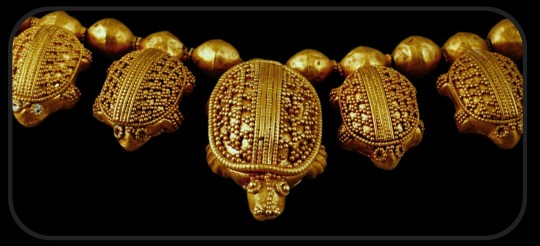
The turtle pendants on this necklace are all decorated with ornate filigree and granulation patterns. The eyes of the 30 smaller turtles were originally made with glass inlay, while the eyes of the largest turtle (seen in the center) were made from drops of gold.
As this article also notes (translated from Georgian):
[This necklace] is unique because of the zoomorphic depiction that it presents. Among the known examples of goldsmithing from antiquity, the depiction of a turtle is not attested anywhere other than the Vani necklace.
The local origin of the necklace is primarily indicated by the stylistic unity of the pendants with other examples of Colchian goldsmithing. It should be noted that the land turtle depicted on the pendants was widespread in Colchis.
The excavations at Vani have uncovered lots of other artifacts made by Colchian goldsmiths. These artifacts include temple ornaments, zoomorphic figures, pieces of jewelry, diadems, headdresses, hairpins, drinking vessels, and appliqués, among other things, and they've provided some really valuable insights into the unique goldsmithing traditions that existed among the peoples of Colchis -- and the myths that evolved as a result.
A few of the other golden artifacts from Vani:
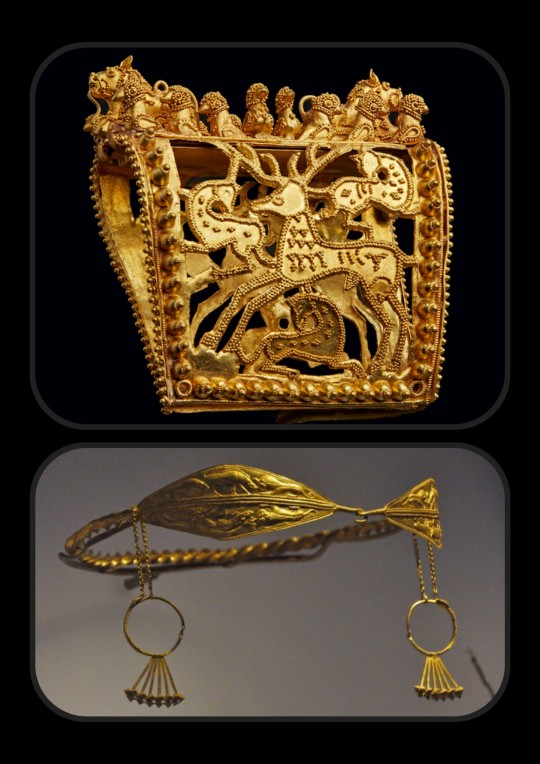
Top: headdress ornament featuring an openwork design, c. 350-300 BCE; the central panel of this piece depicts a stag and three other deer, while the frame is topped by two lions and several rows of birds; Bottom: a diadem with a set of temple ornaments, c. 400-350 BCE; all of the panels along the front of the diadem depict scenes of prey animals being hunted by lions
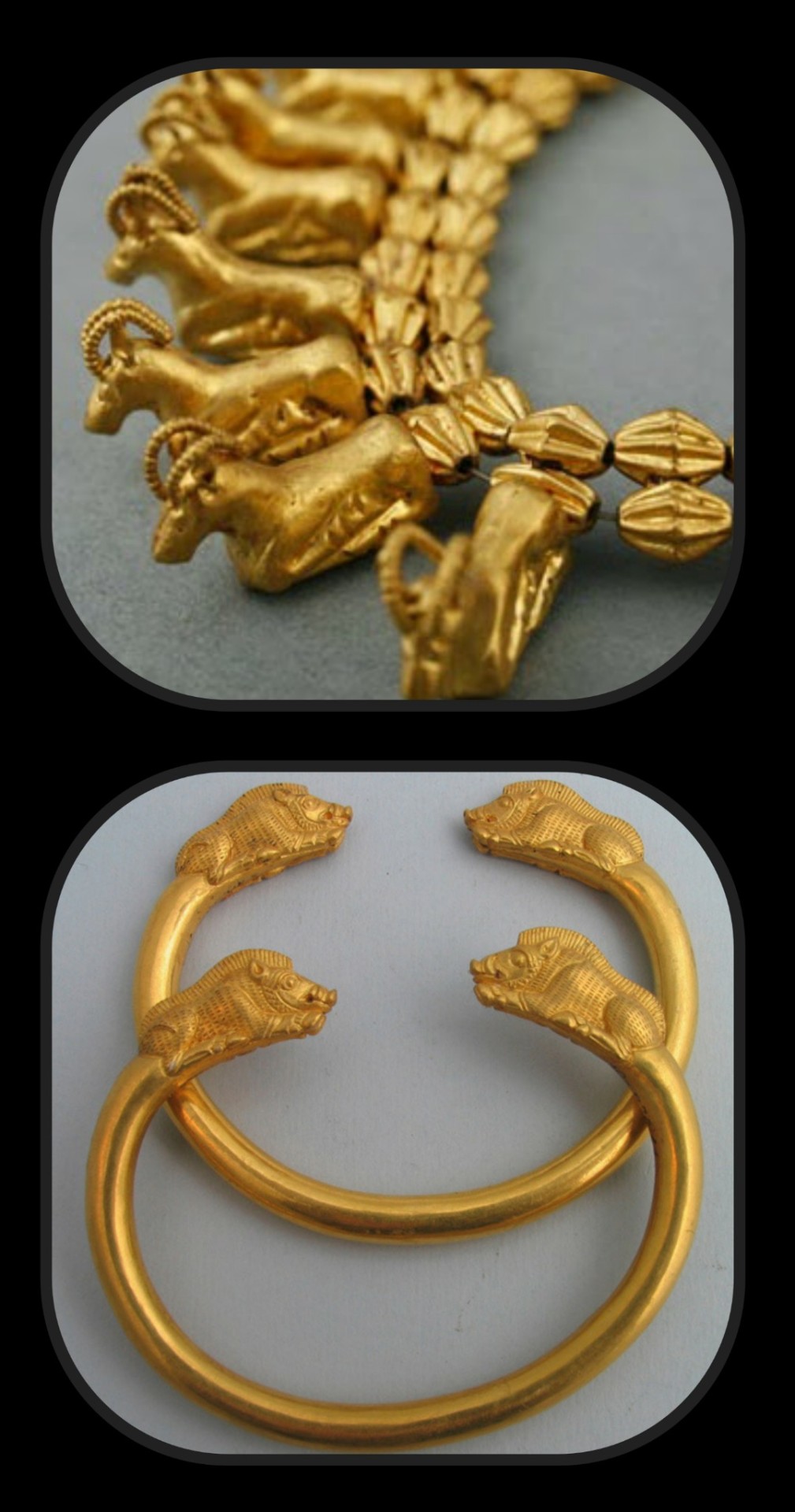
Top: necklace with a series of ram-shaped pendants, c. 400-350 BCE; each pendant was forged from two separate castings that were sealed together to form a complete shape, and the ears/horns were then soldered onto each piece; Bottom: set of bracelets with boar finials, c. 460-440 BCE

Golden appliqués depicting various animals, c. 400-300 BCE

Set of temple ornaments that depict two pairs of riders on horseback, c. 400-350 BCE
And a map showing the location of modern-day Georgia (just for reference):

As this map illustrates, Georgia is nestled right at the crossroads between Europe and Asia, with the Black Sea located on one side and the Caspian not far from the other; it is bordered by Russia to the North and by Turkey, Armenia, and Azerbaijan to the South
Sources & More Info:
National Geographic (Georgian): Golden Kolkheti
Atinati: The Golden Kingdom of Colchis
Smithsonian: Summary of "Wine, Worship, and Sacrifice: the Golden Graves of Ancient Vani" Exhibition
Burusi (Georgian): The Archaeological Discoveries at Vani
Quaternary International: A Modern Field Investigation of the Mythical “Gold Sands” of Ancient Colchis and the “Golden Fleece” Phenomena
#archaeology#history#artifact#ancient history#georgia#sakartvelo#colchis#kolkheti#vani#gold#turtle#jewelry#golden fleece#goldsmithing#south caucasus#mythology#art#applique
2K notes
·
View notes
Text
Some myth busting about Israel's Eurovision participation
Do note that I use countries here when referring to participation. The term broadcasters would be more accurate since a national broadcaster chooses the entrant and the broadcaster is a member of the European Broadcasting Union, the organization behind Eurovision. But a lot of people use the term countries instead of broadcasters, hence why I'm using that word as well.
Myth 1. "Israel isn't even in Europe"
Well, any country that's part of the European Broadcasting Union (EBU), which Israel, Azerbaijan, Armenia, and Georgia are members of, can participate. Same goes for associate members like Australia, hence why Australia is allowed to participate. Lebanon and Morocco could also participate but choose not to because of Israel. In fact, Morocco's only participation was when Israel wasn't participating in the contest, and Lebanon planned to participate but didn't because of Israel's participation. There are rumours going around that this is also the case for Tunisia and Qatar.
Myth 2. "Eurovision banned Russia but not Israel."
Not completely true. Russia was initially going to participate in the 2022 contest, but several countries protested against Russia's participation and threatened to withdraw if Russia was allowed to participate, thus leading to them being kicked out. We will come back to this point about several countries threatening to leave.
Myth 3. "A lot of the artists speaking out about Israel could actually just withdraw from the contest to make a real statement."
You do realize the EBU actually will fine countries if they withdraw too late without good reason? I'm pretty sure a lot of these countries have contracts in place for their contestants, and since the contest is set to take place in mid May, withdrawing would mean possibly being blacklisted from the music industry and losing out on more opportunities. Not for being pro Palestine, but because they backed out on a contract they signed and left the many, many people who work behind the scenes high and dry on really short notice.
Technically not a myth but worth mentioning: 4. "Israel should be kicked out because her presence is a security risk."
Where do we even begin with this? If a country like Sweden, where the contest is being hosted, isn't able to protect its contestants from terrorist attacks, they shouldn't be hosting. It's that simple. I doubt anyone would've said this if Russia was allowed to participate in 2022.
Myth 5. "Eurovision lets Israel pinkwash its crimes."
@pauvrecamille really summed up how a lot of the discourse around pinkwashing can be boiled down to "country I hate gives their gays more rights than one I like." We could talk about how the only transgender winner is from Israel herself.
And if there is a case to be made for pinkwashing in Eurovision, I would argue that it applies more to Russia and Azerbaijan than it does to Israel. At least Israelis can criticize their government and not fear being arrested.
Speaking of Azerbaijan:
Myth 6. "If even one country withdraws from the contest, then that will send a statement to the contest."
Not true. Armenia withdrew from the 2021 contest because of the war with Azerbaijan, while Azerbaijan was allowed to participate in the contest. This is even after we already know they've cheated twice in the contest, on top of the human rights violations. And we could talk about how so many were forcibly displaced because of Azerbaijan hosting the competition in 2012.
We can also talk about how Ukraine withdrew from the contest in 2015 because of Russia's invasion. Russia was still allowed to participate and went on to place second that year.
In 2008, Russia invaded Georgia and in 2009, the Georgian entry was called "We Don't Wanna Put In" which contained veiled references to Putin's invasion. Because Russia was hosting the contest that year, the EBU tried to get Georgia to change their song. Georgia refused and ended up withdrawing.
Remember what I said about several countries threatening to withdraw if Russia was allowed to participate in 2022? It took a total of 10 countries expressing their concerns about Russia's participation and three or four threatening to withdraw if Russia was allowed to actually get the EBU to reverse course on their decision. So there's that.
EDIT: Myth 7: "People wouldn't be bullying the artists for participating in the contest if the EBU kicked Israel out."
Why am I even surprised this is a talking point?


Edit: Myth 8: "Eurovision is treating Israel differently because of the whole lyrics change situation."
I've seen this on both sides, and this is not true. I've mentioned Georgia earlier, but I also want to mention Armenia's 2015 entry, originally called Don't Deny. It was changed to Face the Shadow and allowed to compete. It's reportedly about the Armenian genocide. The point is, stuff like this happens all the time. In 2021, in the midst of protests and lack of freedom, Belarus sent a pro government band with a song containing veiled lyrics threatening to subjugate the protestors. The EBU allowed them to submit another song but ultimately, Belarus was kicked out after they still failed to follow the rules.
So no, this is not out of the norm. At least from what I know. I'm more than happy to edit this section out if I have been proven wrong. God knows I've edited this post many, many times.
Final thoughts:
A lot of the people who are all high and mighty about boycotting Eurovision would absolutely not be doing that if it was Russia participating. They certainly didn't when Azerbaijan did in 2021.
A lot of the misinformation around Eurovision this year can be chalked up to antisemitism and not understanding how contracts work. I think it's also really performative and virtue signaling at best. Yes, it's true that the postcards(clips for the broadcast while preparing for the next performer) for the 2019 contest, held in Israel, where filmed in disputed territories.
Actually, let's talk about the postcards.
You see, KAN, the Israeli broadcaster, chose not to film the postcards in territories like the West Bank. And they were criticized for it by the right wing Israeli government. So there is a true fact about something bad the Israeli government did that you can criticize them for.
Now back to the topic at hand.
Yes, it's true that Israel's lyrics were changed so they could go ahead and participate this year. It's just that now, it's really difficult to have a sane conversation about Israel in general. It's difficult to have a sane conversation about antisemitism with some people. Take this post here trying to combat antisemitism only to end up having to fight Islamophobia. Put a big F in the chat for the OP of that post, yikes.
If no one got called anti LGBT when the World Cup was held in Qatar and people still watched, I don't see why people who choose to watch Eurovision this year should be called pro genocide.
Last but not least, I want to end this on a more positive note, so this year's contest is looking really good. No one's completely sure who will take the win this year, but right now the song with the most bets to win the contest is Switzerland. It's not like 2023, where we all knew who was going to win weeks before the actual contest. So I'm interested in the outcome this year. You guys are more than welcome to throw in your own opinions on this year's caliber of songs if you want.
#a lot of my fellow anti#tankies#will probably appreciate this post because of how much misinformation is going around about Eurovision and Israel this year#hence why I've tagged it as such#eurovision song contest#palestine#stop making the left look bad you donkeys#most of you don't know what you're talking about#israel#misinformation
128 notes
·
View notes
Text
NAKSHATRAS AS GODDESSES
5/27
🌙Mrigashira🦌
DISCLAIMER: This is based solely on my research and the patterns that I saw. I can't promise that I'm gonna be sure in all the coorelations, but I'm going to attribute each nakshatra a goddess that I think fits it the closest. If you're dissapointed, to make up for it, I'm going to list some other deities in the end that I think also fit the nakshatra. Don't come for me if you think I'm wrong, be respectful in the comments if you think so and have fun 🤍
This one is more of a collection of very similar goddesses who are all pretty much well-suited for Mrigashira. I still chose the principal goddess, although it was very hard to focus on only one.
Flidais

Pantheon: Celtic
Name meaning: soft-haired, fair haired.
Associations: Hunting, woodlands, wild animals, cattle, deer.
Symbols: deer
Flidais is a somewhat obscure Celtic goddess of the hunt. She's similar to more famous goddesses: Artemis and Diana, but unlike them, she's not a virgin and her story is different.
The mythology of Mrigashira is about how the seeming perfection of Rohini (the union of sexes) gets shattered. It's the birth of seduction and pursuit between the sexes, this is the place where Eve eats the forbidden fruit and becomes aware that she's separate from the male, not just something to be placed under his submission, as she was in Rohini. In Hindu mythology, when Rohini realizes that she's desired by Brahma, she turns into a doe and flees. Brahma then turns into a deer and chases her, before his head is cut off by God Rudra (God of the next nakshatra_ Ardra), thus, the deers's head being Mrigashira's symbol.
The story of goddess Flidais goes like this: She's unhappily married to a man she dies not love, feeling stuck and not knowing what to do, until another man appears, with whom she shares a deep love. He gets challenged by Flidais's husband, and he wins. As a reward, he gives deer and cattle to Flidais, for her to have something on her own, placing his faith in her. In one myth, she's said to have transformed into a stag.
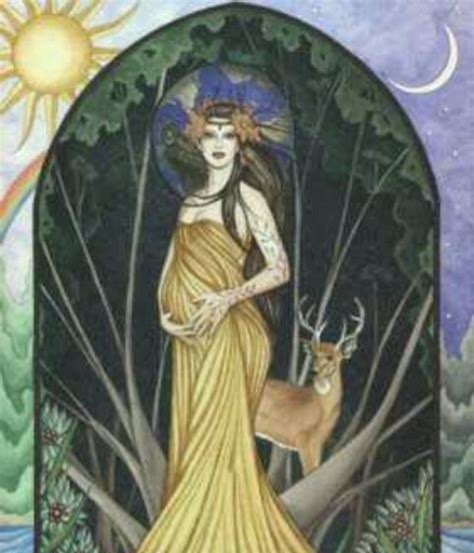
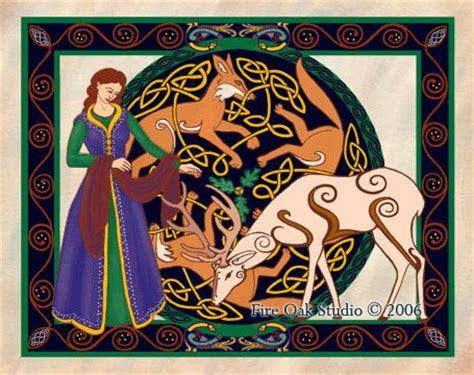
Flidais has a surname, Foltcháin, meaning "beautiful(soft) hair". Mrigashira belongs to a clan of nakshatras called Pulastya (smooth haired).
Besides Flidais, there are other goddesses that can be coorelated to Mrigashira. One of them is Dali- Georgian goddess of the hunt, deer and other horned wild animals. She's said to have beautiful, long golden hair and is the Goddess that governs the rules of the hunt. Either completely nude or dressed only in white, she frequently mated with humans as she wished, just like the female in Mrigashira awakening to her own sexual power. She was said to be unbelievably beautiful, both irresistible and terrible. Dali was harsh with those who violated her rules. She lived in a cavern in a mountain. Parvati, the goddess that was born under this nakshatra, was the goddess of mountains, among other things.
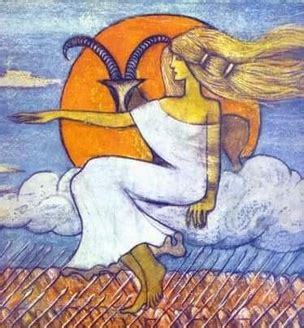
There is also a story about a celtic maiden named Sadhbh, who refused to accept a Druid's advances and because of that, was cursed to be a doe. After three years, the serving man of that druid took pity on her and said that if she were ever to set foot in the dún (castle, fort) of the Fianna of Ireland, the curse would be lifted. Fianna were small bands of warrior-hunters in Ireland during the Iron age and early middle ages. Sadhbh travelled straight to a house that belonged to a Fionn. She was found by him as a doe when he was out hunting. His dogs didn't harm her since they too had been humans before. When they returned to the house, Sadhbh was once again a beautiful girl. They got married.
After Fionn was called to battle against the Vikings, the druid reached Sadhbh and laid the same curse on her, again. Fionn spent several years searching for his wife, but without success. At the end of those seven years he found a wild boy in the forest who said he was raised by a doe. Fionn looked at his face and recognising his wife's features, he realised that he was looking at their son. The boy was Oisín, a famous figure in Irish mythology.
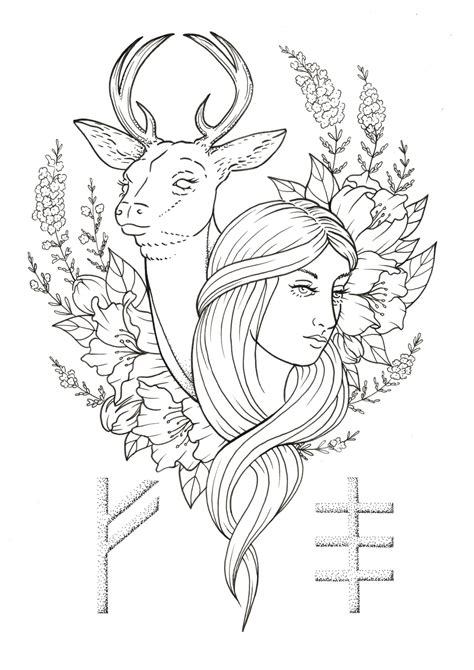
Another interesting deity is the Albanian goddess Zana- goddess of the mountains. Zana were said to be fairies who lived in the mountains and bathed in waterfalls and river streams in nature. They're said to have a very brave character that was known to all. She's a somewhat obscure goddess given her name comes from the name of a creature, but I thought that she was interesting nontheless.
I want to talk about Mrigashira's ruling deity- the moon god Soma. Soma is also known to be the exilir of immortality. Mrigashira's power is to give fulfillment, so to drink Soma, to eat the forbidden fruit, to attain something not everyone has access to is risky, but it's worth the risk. Mrigashira is also associated with quests, adventures and bravery (just like Bharani, the other Venus-Mars ruled nakshatra). The real life natives of Mrigashira are often daring and inquisitive, always craving something else besides what they have.
The moon god being Mrigashira's deity makes me think that Artemis- Greek goddess of the moon, hunting, deer and other wild animals is a great fit for it, but her virginal nature is not in alignment with Mrigashira. If we think of her virginity as simply her being unmarried and independent, then she definitely can be coorelated to Mrigashira. The same goes for Diana- her Roman equivalent.
Some other deities I coorelated to Mrigashira other than Flidais:
Artemis- Greek goddess of hunting, deer, wild animals, the Moon and virgins.
Diana- The Roman equivalent of Artemis.
Dali- Georgian goddess of hunting, deer and other horned wild animals.
Zana- Albanian fairy goddess of the mountains.
Sadhbh- Irish doe-maiden goddess
Cernnunos- Celtic horned god, the god of wild things.
This is it for Mrigashira. I'm very happy I found the Goddesses whose mythologies were so obviously similar to Mrigashira's. As I said, it was hard to choose just one, but I think that I made the right choice, given that Flidais ticked off the most similarities. I'm consistently fascinated by the coorelations between seemingly unrelated cultures and this one was big. It's also my sun, rahu and saturn placement, so no pressure there lol.
Anyways, let me know what you think. Like COMMENT AND REBLOG, please interact with me if you found this interesting. Love you, and take care 🤍🤍🤍
#mrigashira nakshatra#mrigashira#vedic astrology#astrology#nakshatras#astrology observations#goddesses#astro notes#sidereal astrology#celtic paganism#celtic goddesses#georgian goddess#albanian goddess
132 notes
·
View notes
Photo

7 Ancient Sites in Georgia
Georgia, lying at the junction of Europe and Asia, is a country of ancient myths with a rich and turbulent history. Home to the first European hominids and the birthplace of wine, Georgia's roots trace back to ancient civilisations. Throughout its history, the Caucasus region witnessed the influence of various empires and played a crucial role in transcontinental trade routes.
The most famous Georgian kingdom was Colchis, the mythical land of Medea and the Golden Fleece. It flourished from the 13th to the 6th century BCE, thanks to its strategic location along the Black Sea and its abundant natural resources.
Geography
Georgia is between the Black Sea to the west and the Caspian Sea to the east. It is bordered by Russia to the north, Azerbaijan to the southeast, Armenia to the south, and Turkey to the southwest. The country lies mostly in the Caucasus Mountains, and its boundaries are partly defined by the Greater and Lesser Caucasus, two of the world's great mountain ranges and the highest peaks in Europe. Georgia has a diverse, fertile geography with extensive plains and rivers, navigable marshes, deep forests, mountains, and passes. Georgia has about 25,000 rivers. The largest river in western Georgia, the Phasis (now known as the Rioni River), was considered by ancient Greek geographers such as Anaximander of Miletus (l. c. 610 to c. 546 BCE) as the dividing line between Europe and Asia.
Continue reading...
37 notes
·
View notes
Text
Ok so like… on the topic of casting none Greek actors in Greek mythology adaptation, I feel like we don’t consider enough that there are tons of explicitly none Greek characters in the mythology, who either get ignored or whitewashed (and I’m not just talking about Andromeda) and how these casting directors seem only to care to reflect the diversity of America, rather than the diversity of the Mediterranean and Greek mythology as a whole. So it leads to uninspired casting.
Like… cast a Georgian actress for Medea, her foreignness is essential to her character.
Cast a Palestinian actress for Andromeda (since her kingdom is sometimes placed in Jaffa, Palestine)
Cast a Lebanese actress for Europa
Cast a black actor for Memnon
Cast Turkish actors for the Trojans
Cast Egyptian actors for the countless Egyptian characters within myth like Aegyptus and his sons
Cast Moroccan actresses for the Hesperides
Hell, maybe be a bit silly and cast an Arab for Hermes since he’s the father of Arabius the ancestor of Arabs, I wouldn’t bat an eye if you cast an Iranian actor for Perseus or his son Perses since he’s is also said to be the ancestor of Persians.
But at the end of the day, maybe have at least some Greek writers and actors making these movies/shows? I’ve noticed they make them better lol
#greek mythology#ancient greek mythology#greek pantheon#greek tragedy#Perseus#andromeda#Medea#aegyptus#Hesperides#Hermes#Arabius#Perses#Persians#Egyptians#Mediterranean#memnon#Michael Cacoyannis
23 notes
·
View notes
Text


September 3rd 1752 saw the end of the Julian Calendar as we moved to the Gregorian Calendar.
This required a correction of 11 days and Parliament decided that Wednesday 2nd September should be followed by Thursday 14th September with no intervening days numbered 3 to 13. This contemporary comment in the official parish records for Inveraray and Glenaray provides an explanation as shown in the pic:
‘Upon the third of September this year the computation of time has been changed from the Julian to the Gregorian calculation so that the third day of September is reckoned the fourteenth NS and all the dates thereafter in the register are according to the Gregorian or new stile and all the former to the Julian or old stile.’
There are instances of unrest quoted for this day, as many people mistakenly believed that their lives would be shortened by 11 days. People were also unhappy and suspicious at the moving of saint’s days and holy days, including the date of Easter. Many people also objected to the imposition of what they saw as a ‘popish’ calendar.However, most historians now believe that these protests never happened. You could say that the calendar rioters were the late Georgian equivalent of an urban myth.
25 notes
·
View notes
Photo






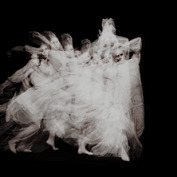


myth moodboards: batonebi
spirits of disease in georgian mythology
requested by anon
222 notes
·
View notes
Photo









georgian mythology: barbale
barbale is the goddess of cattle and poultry fertility, the sun, women's fertility, and healing.
#i love doing split moodboards#georgian mythology#barbale#goddesses#georgian myth#mythedit#*mine*#requested
238 notes
·
View notes
Text
"As you care not a bit about my wishes, I have decided to take my own pleasures in hand. As long as I receive invitations to adventure, I shall accept them."
Sarah McLean, A Rogue by Any Other Name
#book quotes#bookish quotes#book quotations#sarah maclean#a rogue by any other name#georgian era#regency era#regency romance#greek retelling#greek myth retellings#hades and persephone#hades x persephone retelling#hades x persephone#page 319
6 notes
·
View notes
Text
I can't do this anymore! (about the historian student's sore point)
I study at the Herzen State Pedagogical University, to become a historian (not a teacher!) and I have accumulated a lot of unpleasant situations from my life as a student of the above-mentioned university.
The fact is that I am madly in love with Paul I, Arakcheev and Peter III.I'm ready to tell you everything I know about them: myths, tales, facts unknown to ordinary people, etc.I've read a lot of books about them, listened to lectures on the Internet (yes, and Mr. Medinsky's lectures too, purely out of interest).I love their history and sincerely want to better reveal them to ordinary people, which is why I enrolled in the historian.
But I have people in my course who came out of school with school knowledge, passed the Unified State Exam (so that it burns in hell) and enrolled in a historian.
Fuck, it would be better not to do it, please excuse me, but this is a nightmare!90% of my classmates are ardent politicians and I sincerely do not understand why the hell they went to the historian!? It would be fine if they talked about politics, but they did not look beyond the history textbook and Klim Zhukov's lectures (although I may be mistaken). But that's not the point.
In my first year, I told them about my love for the aforementioned historical figures. And then it startedI argued with them about the foreign policy of Peter the Third, about the personality and tragic death of Paul the First, about the character of Arakcheev and military settlements, and even about the domestic policy of Nicholas the First.
And now I am a laughing stock, loving men in the uniform of the 18th and 19th centuries, aggressively reacting to any ridicule of Paul I and Peter III (for some reason they only remembered them).
I don't want to prove anything, I just want people to open their eyes to these people.:Arakcheev is not a callous soldier. (Have you seen his Georgian estate!? It says a lot about its owner!)He was helping people,he commuted the sentences of the military, took care of the education of military people.Paul I did not deserve to be laughed at for his death (my classmates openly laughed at his murder).
I just can't keep quiet about it anymore. I'm tired of making fun of them.
#hello from russia#paul i of russia#arakcheev#i'm sick of it#Peter the Third#Historical everyday life#Nicholas the First
10 notes
·
View notes
Text
Mount Stuart



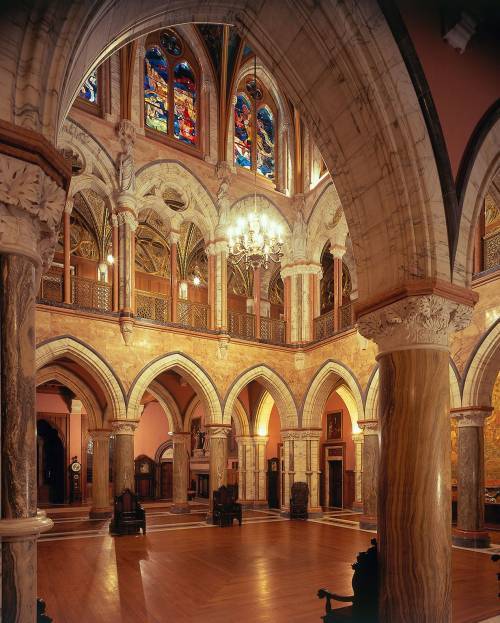

Mount Stuart is located on the east coast of the Isle of Bute in Scotland. The Gothic Revival country house was built in the 19th century. The house was built upon an earlier 18th century home severely damaged by a fire in 1877. The Georgian wings and much of the contents survived the fire and were incorporated into the new castle by the 3rd Marquess of Bute. The opulent interior boasts carved paneling, painted mirrors, a spiral staircase, a chapel, and much more. The Marble Hall has a map of stars on the ceiling and 12 stained glass windows depicting the signs of the zodiac moving through the seasons on the walls. The Gallery’s ceiling is decorated with winding branches from the Tree of Life, which frame the classical heads of 128 goddesses from ancient myth and legend. The house has collections of art and artifacts, including works by Ramsey, Reynolds, Gainsborough, as well as books, furniture, silverwork, porcelain, and Shakespeare’s First Folio. The estate has 300 acres of gardens that include a rock garden, a kitchen garden, an arboretum, and pinetums. The castle is used as a venue for weddings and corporate events. Mount Stuart can accommodate 37 guests in 22 separate areas around the house. There is a visitor center, a shop, and the Courtyard Café and Bakehouse.
21 notes
·
View notes
Text
I care for neither fugues nor feathers.
What interests me most is the people
Who have always interested me most,
To see them without their passions
And to understand them.
Perhaps, without their passions, they will be
Men of memories explaining what they meant.
One man opposing a society
If properly misunderstood becomes a myth.
I fear the understanding.
Death ought to spare their passions.
Memory without passion would be better lost.
But memory and passion, and with these
The understanding of heaven, would be bliss,
If anything would be bliss.
How strange a thing it was to understand
And how strange it ought to be again, this time
Without the distortions of the theater,
Without the revolutions' ruin,
In the presence of the barefoot ghosts!
Perception as an act of intelligence
And perception as an act of grace
Are two quite different things, in particular
When applied to the mythical.
As for myself, I feel a doubt:
I am uncertain whether the perception
Applied on earth to those that were myths
In every various sense, ought not to be preferred
To an untried perception applied
In heaven. But I have no choice.
In this apologetic air, one well
Might muff the mighty spirit of Lenin.
That sort of thing was always rather stiff.
Let's hope for Mademoiselle de Lepinasse,
Instead, or Horace Walpole or Mrs. Thrale.
He is nothing, I know, to me nor I to him.
I had looked forward to understanding. Yet
An understanding may be troublesome.
I'd rather not. No doubt there's a quarter here,
Dixhuitième and Georgian and serene.
Wallace Stevens, "Lytton Strachey, Also, Enters into Heaven," from Collected Poetry and Prose
#wallace stevens#lytton strachey also enters into heaven#collected poetry and prose#out of my collection
7 notes
·
View notes
Text
Bravado on the gallows
[abridged excerpt from V.A.C. Gatrell's The Hanging Tree: Execution and the English People 1770–1868, Chapter 1.1: “Dying Bravely”, emphasis mine]

the most iconic depiction of a procession to the Tyburn gallows, with the condemned on a cart going through excited crowds: William Hogarth's The Idle 'Prentice Executed at Tyburn, from the Industry and Idleness series (1747)
In theory, a Londoner growing up in the 1780s could by 1840 have attended some four hundred execution days outside Newgate alone. If he was unimaginably diligent he could have watched 1,200 people hang (and there were such obsessives). The sanction of the gallows and the rhetoric of the death sentence were central to all relations of authority in Georgian England. But the gallows were also embedded in the collective imagination, the subject of anxiety, defence, and denial, of jokes, ballads, images, and satire, and of primal gratifications too.
Even today we take comfort from an exuberant and cheering fantasy of what public hangings were like, and hence blur the memory of what the noose really did to people. A pleasant myth shields us from the reality of the process. It is not that the myth was without basis. It is what it concealed that is in question.
Central to the fantasy is the memory of the felon’s procession to Tyburn before 1783. To surface appearances it all seems rather jolly, and in certain dark senses it was so:
As clever Tom Clinch, while the rabble was bawling,
Rode stately through Holborn, to die in his calling;
He stopped at the George for a bottle of sack,
And promised to pay for it when he came back.
– J. Swift, ‘Clever Tom Clinch going to be hanged’ (1726/7)
From Newgate prison the condemned were conveyed in open carts along Holborn, St Giles, and Tyburn Road (later Oxford Street) to the triangular gallows at the foot of the Edgware Road. The major stations in this parodic progress to Calvary were at inns like the Bowl on the corner of St Giles’ High Street, or the George in Holborn, where the condemned would be offered wine; then Tyburn itself; and then again at Surgeon’s Hall at the Old Bailey, where murderers’ bodies were displayed and dissected.
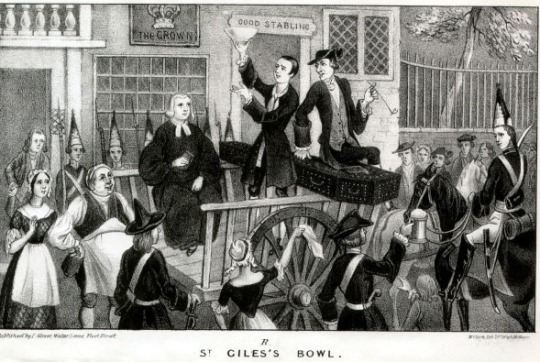
Thief, escape artist, and folk hero Jack Sheppard taking his last drink at St Giles
Playing as best they could to the crowd’s admiration and engaging in parodic dialogue with it, some felons on their way to their doom constructed the illusion that they were the masters of the ceremonies, and not the City marshal, under-sheriff, priest, constables, and javelin-men who were meant to impart solemnity and security to the procession. Lord Ferrers’s composure on his journey to Tyburn in 1760 ‘shamed heroes’, Horace Walpole reported. Hanged for murdering his servant, he bore the procession ‘with as much tranquillity as if he was only going to his own burial, not to his own execution’. Plebeians also put on fine displays:
The vilest rogues, and most despicable villains, may own a thousand crimes, and often brag of the most abominable actions; but there is scarce one, who will confess that he has no courage... The further a man is removed from repentance, nay, the more void he seems to be of all religion, and the less concern he discovers for futurity, the more he is admired by our sprightly people.
– B. Mandeville, An enquiry into the causes of the frequent executions at Tyburn (1725)
When Lewis Avershaw was hanged on Kennington Common in 1795 he appeared ‘entirely unconcerned, had a flower in his mouth, his bosom was thrown open, and he kept up an incessant conversation with the persons who rode beside the cart, laughing and nodding to acquaintances in the crowd’. He was afterwards hanged in chains on Wimbledon Common, and ‘for several months, thousands of the London populace passed their Sundays near the spot, as if consecrated by the remains of a hero’. ‘Sixteen-string’ John Rann in 1774 wore a peagreen coat, a nosegay in his buttonhole, and nankeen small-clothes tied at each knee with sixteen strings. At the gallows he sustained the demeanour of his last dinner-party in Newgate, where the company had included seven of his girls and ‘all were remarkably cheerful’. Thanks to the crowds and the convivial exchanges en route, a popular daredevil like this might take two hours to travel the couple of miles to his Tyburn death.

The Newgate Drop in action, 1809
Nor did this festive tradition die when the scaffold was removed to Newgate’s exterior in 1783. At Holloway’s and Haggerty’s hanging in 1807 both men ‘conducted themselves with the most decided indifference’. Holloway ‘with an affected cheerfulness of countenance... jumped upon the scaffold when he had ascended the ladder, his arms being pinioned with a rope behind... got his hat between his two hands, and as well as he was able, bowed to the crowd repeatedly... with a view to show that he died game, as it is expressed.’ He announced his innocence, refused to pray, and told Haggerty to ignore the clergy-man. Ascending the Newgate scaffold in 1829, Thomas Birmingham ‘was instantly greeted by a vast number of girls of dissolute character in the mob, who called out repeatedly—“Good bye, Tom! God bless you, my trump!” In the 1830s the ballad of the condemned Sam Hall conveyed the tone of these scaffold exchanges:
I saw Nellie in the crowd,
And I hollered,—right out loud—
‘Say Nellie, ain’t you proud—
Damn your eyes’ .
These mocking postures were mainly metropolitan but not exclusively so. Before his execution at York in 1739, Dick Turpin employed five mourners to follow his cart to the scaffold.
Self-parody and the display of courage was one way of dealing with terror. Defiance was another. An agricultural worker executed in Kent for arson during the Swing disturbances in 1830 declared his innocence to the last and ‘refused to pull the cap down over his eyes, saying he wished to see the people’ as he died. Others spurned God and his priests. When the highway robber Norton died game in 1827 he refused religious consolations. When a schoolmaster in Newgate sought to persuade a condemned man that there was a future life, the reply got to the truth of it: “Why you too gammon on as well as the parson! They take your life away, and then they think to make amends by telling you of another and a better world; for my part I am very well satisfied with this, if they will let me stay in it.’

Thomas Rowlandson, Malefactors on Their Way to Tyburn (c. 1776–1827)
Then there was the determined care about dress. Best clothing was worn by those who could afford it. Few men now dressed as Lord Ferrers had in 1760, in his wedding suit of white and silver, or paraded symbols like the white cockade the burglar Waistcott wore in his hat in 1759 ‘as an emblem of his whole innocence’. Male dress was becoming sober. Hatfield wore a black jacket with waistcoat, fustian pantaloons, and white cotton stockings; Fauntleroy ‘a new suit of black, silk stockings of the same colour, and light pumps’. But women continued to affect sartorial gaiety. Elizabeth Fry found that the ‘chief thought’ of nearly every condemned woman in Newgate ‘relates to her appearance on the scaffold, the dress in which she shall be hanged’. When Christian Bowman was hanged and burnt outside Newgate in 1789 she was ‘drest in a clean striped gown, a white ribbon, and a black ribbon round her cap’. In 1815 Eliza Fenning wore the dress she was to have worn for her wedding, a ‘white muslin gown, a handsome worked cap, and laced boots’.
Striking in all this is the victim’s effort to maintain dignity to the last and to die well, by drawing on a supportive vein of cynicism which ran deep in popular culture. Also striking is the authorities’ tolerance of these efforts. Those with money could spend their last days in Newgate in dissipation, as John Rann did, along with the highwayman Paul Lewis in 1763 when he entertained guests in the condemned cell by singing bawdy songs and vilifying the parson. On the scaffold likewise, custom had long entitled the condemned to address the crowd as they pleased, seditiously if they chose. Although every effort was made to force them to public professions of guilt and penitence, they were not checked if they betrayed that role. Jacobites had betrayed the role spectacularly, some making seditious speeches ‘plainly calculated’, as Dudley Ryder had observed, ‘for nothing else but to incense the people against the government... A rogue cannot be hanged but he must become a saint upon the gibbet.’

Dr Johnson lamented the abolition of the Tyburn procession: ‘the old method was most satisfactory to all parties; the publick was gratified by a procession; the criminal was supported by it. Why is all this to be swept away?’ This comment is usually taken to indicate bluff Augustan heartlessness. But its key word was ‘support’, and the generosity of Johnson’s observation is clarified in Adam Smith’s amplification of it:
A brave man is not rendered contemptible by being brought to the scaffold. The sympathy of the spectators supports him, and saves him from that shame, that consciousness that his misery is felt by himself only, which is of all sentiments the most insupportable... He has no suspicion that his situation is the object of contempt or derision to any body, and he can, with propriety, assume the air, not only of perfect serenity, but of triumph and exultation.
Johnson’s and Smith’s insights take us at last beyond the jolly surface of these rituals to the bleaker truth which social memory has censored—that most felons went to their deaths in quaking terror. In this light the abolition of the procession and the long shift towards the privatization of execution, commonly understood as a progressive and humane movement, was the reverse of that. To kill felons without ceremony and in private was to deny them the only worldly support they could hope for in their last hours. As evangelicals had their cool say on the best chances of bringing the felon to penitence, the felon was to be left alone with his death, that his spirit might break. [n.b. The author does have a point here (it’s truly horrible to die all alone, without an audience and without your loved ones, at the hands of cops, priests and bureaucrats), but this take ignores that the crowd’s support was not a given; for some they cheered, but for others they cursed, heckled, mocked, threw mud etc]
While public executions lasted, many knew that outward bravado did not speak for a felt reality, and that the powdered wig, Holland shirt, gloves, and nosegays which some flaunted on their last journey was the only resort they had to ‘meliorate the terrible thoughts of the meagre tyrant Death’. The man who did contrive to conduct himself bravely was often actually drunk out of his mind:
But valor the stronger grows,
The stronger liquor we're drinking,
And how can we feel our woes,
When we've lost the trouble of thinking?
— V.A.C. Gatrell, The Hanging Tree: Execution and the English People 1770–1868 (Oxford University Press, 1994)
#V.A.C. Gatrell#theory#swinging from the gallows tree#The Hanging Tree: Execution and the English People 1770–1868#the potatoes of defiance#england#london#I love it when I abridge excerpts#and they're still 17 screens long
35 notes
·
View notes